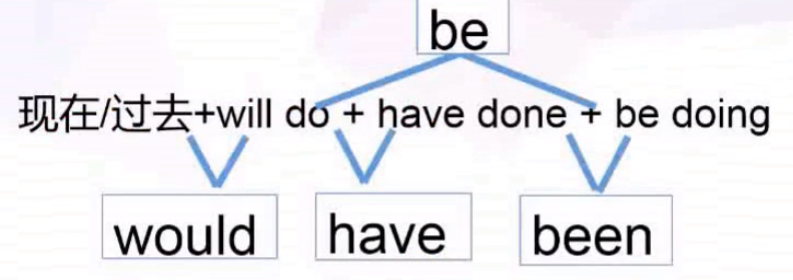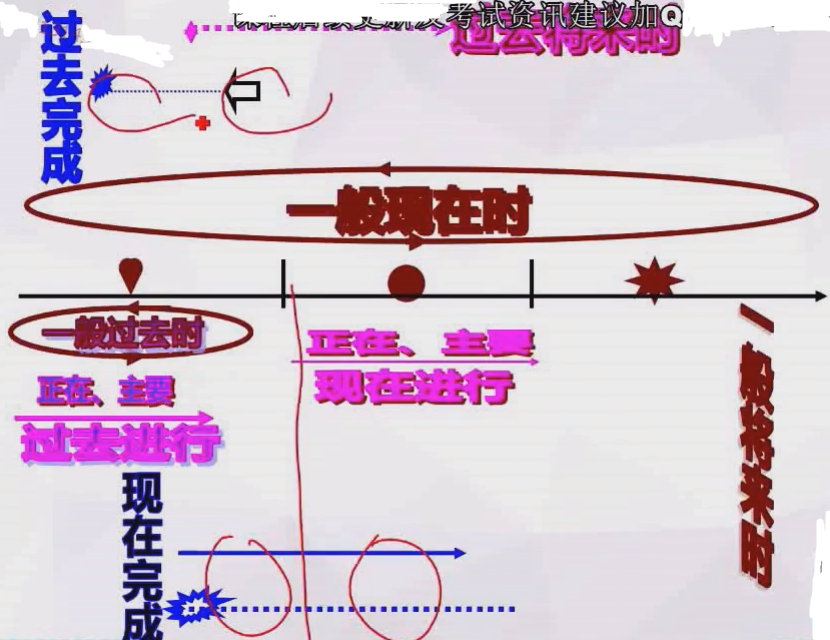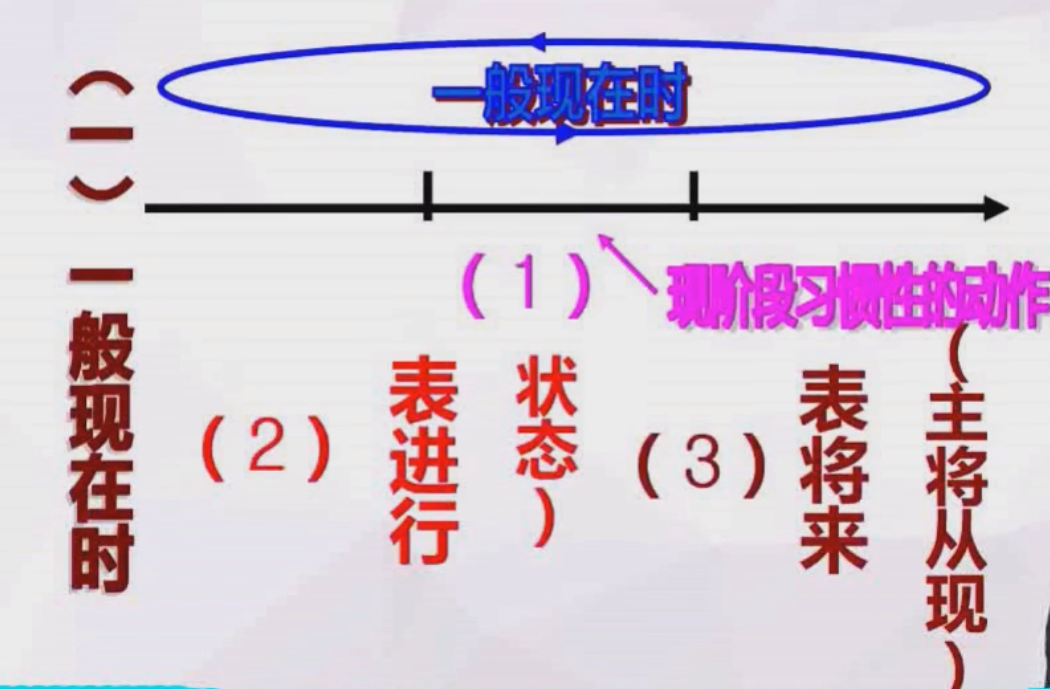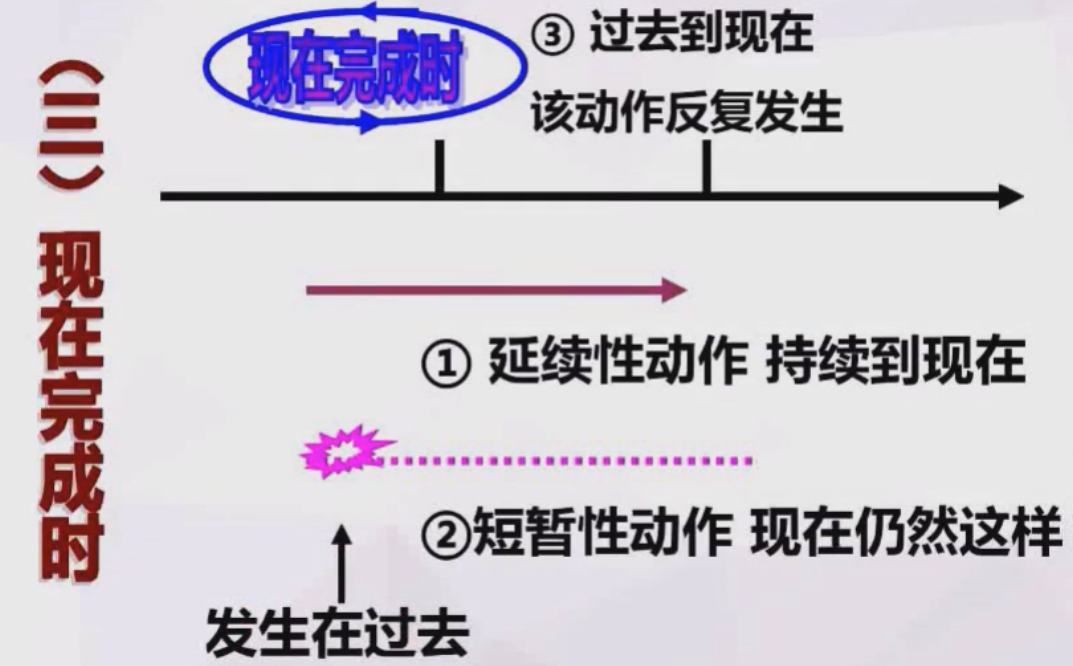雅思核心语法
一、导学课程
雅思语法特征
- 不做直接考察
- 听、说、读、写的敲门砖
- 重点:句法(时态、虚拟、从句、非谓语)
课程内容
1. 时态
对应课本:
- 第1-6章:现在时态 / 过去时态 / 现在完成时 / 将来时态
- 第22章:被动语态
- 发生在过去: did / was doing / had done / have done / have been doing / would do
- 发生在现在: do / is doing
- 发生在将来: will do / will be doing / will have done
2. 虚拟语气
对应课本:第17-18章 基于条件的可能性
课本:
零条件句 —— 真理或事实(本课略过)
特点:主从句都用现在时态。
- If you own a car, you have to pay for insurance every year.
- If you decide to study in the UK, you must pass this examination.
第一条件句(主将从现)
主将从现是指在时间状语从句、条件状语从句和让步状语从句中,如果主句表达将来含义,从句用一般现在时替代一般将来时。
- If you leave your money in the bank, you won’t earn any interest and it may lose value over time.
第二条件句(对现在和未来的虚拟)
第三条件句(对过去的虚拟)
混合条件句(错综虚拟)
3. 情态动词
对应课本:第13-14章
4. 定语从句
对应课本:第20章 关系从句
5. 名词性从句(p186主语从句)
6. 状语从句(p198概念之间的衔接)
对应课本:无完整部分。必须补充点
7. 非谓语动词 to do, doing, done
对应课本:第16章 动词+动词形式
课本:内容浅,建议学员自己记忆。针对非谓语动词做宾语。
本课:内容丰富。针对不同形式的非谓语的使用(非谓语动词做主语、状语、定语),为作文的高级句型和阅读长难句打基础。
8. 名词
对应课本:第7章 可数和不可数名词
9. 形容词副词
对应课本:第10-11章 形容词和副词+比较事物
本课中未详细涉及到的课本内容
特点:简单(不太容易影响到阅读长难句和写作)
1. 第8章 指称名词(与名词相关)
冠词:表示名词是否确定
- 确定:the
不确定:
- 可数单词 a
- 不可数 / 可数复数 “/“
2. 第9章 代词
- 人称代词:主格 / 宾格 (I / me)
- 反身代词: ** self (myself)
- it 形式主语(主语很长)
3. 第12章 名词短语 —— 可以修饰名词的(定语)
放在名词前
- 代词this
- 形容词
- 名词: an english book
非谓语动词(doing/done形式):a developing/developed country
特点:一个词(即使是一堆形容词,也是独立的)
放在名词后面
- 介词短语
非谓语动词
特点:多于一个词
the place to visit
- the rubbish lying at the bottom of the harbour
4. 第15章 间接引语(时态变化、搭配)
直接引语:he said: “I love you”.
引号中用现在时。
间接引语:he said he loved me.
引用的内容变成了过去式。
一些固定搭配:
- teacher said: “…”
- teacher asked me to do sth.
5. 第19章 介词(搭配)
6. 组织文章的方式 —— 文章的主语
强调句: it is/was + 被强调部分 + that + 其余
被强调的部分:除了谓语都可以
举例:
I met Mary at the airport yesterday.
- It was yesterday that I met Mary at the airport.
- It was I that met Mary at the airport yesterday.
7. 第24章 在文章表面你的立场
8. 第25章 书面英语中的名词化(写作小细节,语法课暂不详述)
举例:
名词比动词更高级
- I visited museum.
- I paid a visit to museum.
二、时态语态
时态的构成
1. 时:时间
- 过去
- 现在
- 将来
- 过去将来:我小时候的梦想是成为一个科学家。那我什么时候是科学家呢?过去(小时候)的将来(梦想)。
2. 态:动作完成的程度
- 一般:在这个时间段里一直都这样
- 进行:在这个时间段里没做完
- 完成:在这个时间段里做完了
- 完成进行:快完成了还没完成,还需要做一小段时间
3. 时态
| 一般 | 进行 | 完成 | 完成进行 | |
|---|---|---|---|---|
| 过去 | ||||
| 现在 | ||||
| 将来 | ||||
| 过去将来 |
时态构成的公式
现在/过去 + 将来 + 完成 + 进行
现在/过去 + will do + have done + be doing

举例:
- 过去完成进行时: had been doing
- 将来进行时: will be doing
- 将来完成时: will have done

若动作发生在过去
1. 一般过去时(did、was/were)
过去某特定时间的动作或状态(在时间坐标轴上是一个点)
比如:我昨天下午摔倒了。其中的”摔倒了”肯定是一个点。
过去经常反复发生的动作(在时间坐标轴上是一个圈)
比如:我过去常常做某事。

从上图中可以看出, 一般过去时只能发生在过去,暗含现在已经不再发生了 。
2. 过去进行时(was/were doing)
用法:过去某个时间正在发生
本质:
- 强调当时没有完成
- 为其他动作提供背景(when、while)
It happened at five in the afternoon while she was watching the news on TV.
3. 区别:一般过去时 VS 过去进行时
一般过去时
- 已完成(现在不再发生)
- 强调结果
过去进行时
- 当时未完成
- 当时的背景
- 强调过程
4. 过去完成时 had done
用法:过去的某时刻前已发生。
本质:过去的过去。
注意:若连续发生,则用 did 。比如:我走过来,推开门,坐下。
例题: The moment I got home, I found I ___ my jacket on the playground.
- A. had left
- B. left
- C. have left
- D. was leaving
注意: find 是紧接着 get home 发生的,是连续发生的,所以用 found 。

若动作发生在现在
1. 一般现在时

- 现阶段习惯性的动作表示过去、现在以及可预见的未来习惯性的动作。比如:我常常坐公交车上班。
- 表进行(状态)表达正处于的状态时用一般现在时。比如:我想和咖啡。我喜欢你。
- 表将来(主将从现)
说明:
蓝色的圈(横跨过去、现在、未来)中的一般现在时表示过去、现在和未来一直都这样,一般用于:
- 客观真理。比如:日出东方。
- 时间表。比如:车站时间表。
主将从现是指主句 表示未来(不一定有will) ,从句用现在时。
- 时间状语从句:when, before, as soon as 等
- 条件状语从句:if, unless, as long as 等
- 让步状语从句:**ever, even if 等
2. 现在进行时
现在进行时和过去进行时的共同本质是没完成,相同的性质:
- 片段性(此刻正在发生)
- 阶段性(目前阶段一直发生)
现在进行时的特殊点:强调变化趋势、发展进展、语气、态度。
3. 现在完成时
现在完成时:发在过去,和现在有关系

注意:现在完成时在坐标轴上横跨了过去和现在两个时间段。
现在完成时含有 现在还这样 的意思。
延续性动作
I have lived here for 3 years.
我已经在这里住3年了(现在依然在这里住)。
短暂性动作
I have collected plenty of information.
我已经收集了很多信息(并且这些信息依然在)。
反复性动作
I have called him three times.
我已经给他打了3次电话了。
用于完成时的句型
It is/was the first/second time that + 现在完成时/过去完成时
This is the first time that I’ve ever needed an operation.
This is/was the + 最高级 + 名词 that + 现在完成时/过去完成时
This is the ugliest baby that I’ve ever seen in my life.
现在完成时 + since + 一般过去式
- ___ you ___ Dr.Jackson for a long time?
- Yes, since the ___ the Chinese Society.
- A. Have known; joined
- B. Did know; joins
- C. Have known; had joined
D. Did known; joined
选择 A 。
4. 现在完成进行时
现在完成进行时
- 发生在说话前(发生在过去)
- 持续到说话时(刚停或扔进行)
比完成时多了进展和语气。
若动作发生在将来
1. 一般将来时
will do (预测;临时决定)
举例:Tell me all about it and I will pass on the information to the rest of the team.
is/are going to do (有计划)
举例:We are going to hire a bus.
be about to do (即将,马上,常与when连用)
正要做什么时,什么事发生了。几乎同时发生。
举例:I am about to go to the airport when he calls me.
2. 将来进行时 will be doing
本质: 将来的 具体的那个时候 ,正在做。
举例:
- Can I call you at 8 o’clock tonight?
- No, I will be working on the report then.
3. 将来完成时 will have done
本质: 截至到 将来某个时间,已经完成了。
特征:截止到 —— by, until, before
举例: I will have finished it by next Friday.
4. 将来完成进行时 will have been doing
本质: 截至到 将来某个时间 ,已经做了多久。 强调过程。
特征:
- 截止到 —— by, until, before
- 做多久 —— for + 一段时间
举例: By next Friday, I will have been working here for ten years.
三、虚拟语气
- 本质: 假的
- 表现形式:时态;情态动词
if 后面的是从句
举例:
- If it rains tommorrow, we will stay at home.
- If it had rained yesterday, my vegetable wouldn’t have died.
- I should have gone with him.
虚拟语气中的时态
| 时态 | 从句动词 | 主句动词 |
|---|---|---|
| 与现在相反 | 过去时 did,were(不能用was) |
过去将来时 would/could/might/should + do |
| 与过去相反 | 过去完成时 had done |
过去将来完成时 would/could/might/should + have done |
| 将来不可能 | 过去的将来 were to do 同现在 should do |
would/could/might/should + do |
第二列在第一列时态的基础上退一格,第三列在第二列的基础上加将来时。
- 如果是虚拟语气,必须写成过去的样子。
- 遵循原则”从退主将”:从句的时态(相比表达的事在时态上)退一格,主句在从句的基础上变将来。
虚拟语气中的情态动词
情态动词 + have done
表示对过去事情的遗憾、惋惜
- should have done 本应该
- needn’t have done 本不必
- could have done 本来能
- might have done 本可能
虚拟语气的句型
- 主句假的,从句假的(if句型)
主句真的,从句假的
从句时态比主句退一格。
wish that … (对将来虚拟时使用would do)
I wished that I had been a boy then!
as if / as though …
He always talks a lot as if he knew everything!
would rather …
I would rather you came tomorrow.
主句假的,从句假的,但从句被短语或事实替代
with, without, but for
but for 翻译为 “要不是因为”
I couldn’t have won the game but for/without your help last week.
= I couldn’t have won the game if you hadn’t helped me last week.
but, otherwise
I have no money, otherwise I would lend it to you.
= If I had money, I would lend it to you.
四、情态动词
常见的情态动词
1. can / could
表示能力。
仅在表示能力时,could才是can的过去式。
- I can swim.
- He couldn’t open the door because his naughty boy had locked it from the inside.
表示许可
could比can更委婉一些。
- Can I borrow the car now?
表示”有时会”
- It’s always cold in Zhejiang in winter but it can be warm at times.
表示对现在的推测,”可能”
此时can等同于could
can常用于否定句和疑问句中。can在肯定句中表示的是能,会的意思。
如果表示肯定的推测,需要用may。
2. may
推测,”可能”
用于肯定句和否定句。
may用于疑问句表示请求、祈求,而不是可能的意思了。
- may not 可能不 (can’t = couldn’t 不可能)
may well not 很可能不
举例:
What are you doing this Saturday?
I’m not sure, but I ___ go the Rolling Stones concert.
填 might 。
请求
May I come in?
3. must
表推测,”一定是”
只能用于肯定句中。
用于否定句时表示禁止。
表必须
- must 说话人主观要求
have to 客观规则
举例
You must buy a book before the class.
- I am going to Florence next week so I will have to buy a guidebook.
疑问句中,常翻译成”非得”
Must you play the guitar so loudly? I can hardly pay attention to my book.
4. need
need to do sth,此时need是实意动词
need do sth,此时need是情态动词
做情态动词不能用于肯定句
dare 做情态动词也不能用于肯定句
- Need I go there with you?
- You needn’t do it.
做实意动词
- need to do
need doing = need to be done 主动时态表被动含义
The flowers need watering. = The flowers need to be watered.
情态动词 + have done
表示对过去的推测
- must have done 过去一定
- can’t/could’t have done 过去不可能
- may/might have done 过去可能
表示对过去的遗憾、惋惜 “本”
虚拟语气中不用任何现在的形式
- should have done 本应该
- could have done 本来能
- might have done 本可能
- needn’t have done 本不必
五、定语从句
概念
1.定语
用来修饰名词的成分
2. 定语从句
用来修饰名词的从句
3. 先行词
被修饰的名词
举例
The beauty of a woman is not in the clothes which she wears, or the figure which she carries. The beauty of a woman must be seen from her eyes, the place where love resides.
其中 the clothes, the figure, the place 是先行词。
后面的 which, which, where 是关系词们用于联系 the clothes 和 she wears 的关系和在语法上代替 the clothes 作为 she wears 的宾语。
4. 关系代词
关系
- 重复指代先行词
- 连接主从
代词
- 功能:代替先行词在从句中做人、物(事)
- 特点:如果缺少,从句在语法上不完整
5. 关系副词
关系
- 重复指代先行词
- 连接主从
副词
- 语法上可有可无
- 一般修饰动词或整个句子,用做状语:时间,地点,原因
- 功能:代替先行词在从句中做状语
- 特点:如果缺少,从句在语法上依然完整
关系词
- 指代人:who, whom,that
- 指代事物:which, that
- 所属关系:whose, of which
- 指地点:where
- 指时间:when
- 指原因:why
如何写一个定语从句的句子
1. 前提
两个简单句,有相同的名词
或者
第二个句子有一个代词,指代整个第一个句子
2. 步骤
定主次(次放后)
去次名
加关系
3. 根据去的名词加关系词
- 若去名词,加which, who, that
- 若去名词’s , 加 whose
- 若去介词短语(in/on/at等 + 名词),加where, when, why
4. 例句
Some students take a year out before university. This allows them to work or travel.
Some students take a year out before university which allows them to work or travel.
The Guggenheim Museum is in bilbao. It only displays contemporary art.
The Guggenheim Museum is in bilbao which only displays contemporary art.
删掉的只是 Museum ,不是 in Museum, 所以不能用 where。
My English teacher is leaving. His lectures are very interesting.
My English teacher is leaving whose lectures are very interesting.
The lecture was about current economic policy. It was not very easy to understand.
The lecture was about current economic policy which was not very easy to understand.
In 1951 my parents arrived in New York. They stayed there for the rest of their lives.
In 1951 my parents arrived in New York where they stayed for the rest of their lives.
I gave my assignment to the faculty secretary. She was not very friendly.
I gave my assignment to the faculty secretary who was not very friendly.
六、名词性从句及状语从句
名词性从句
判断从句
本质: 从句 = 名词
一般情况下,名词可用作:
- 主语
- 宾语
- 表语
- 同位语
判断: 去掉从句后,剩余部分不完整
例外:
- It 做形式主语
- 名词作同位语时构成同位语从句
连词的选用
- 从句不完整:what, who
从句完整,看翻译:
不用翻译: that
需要翻译: whether/if; where; when; how; why; which(哪一个)等
例句:
___ people kill too many animals for money makes animals endangered.
解析:”___ people kill too many animals for money” 这一段使得动物灭绝,如果去掉,makes 就缺少主语,所以 “___ people kill too many animals for money” 这一段是主语从句(名词性从句的一种)。 主语从句本身很完整且连词也不用翻译,所以连词选用 that .
___ makes animals endangered is ___ people kill too many animals.
解析:is 前面的句子是主语,后面的是表语,is 本身是系动词。这是一个主系表结构。主语从句 “___ makes animals endangered” 中缺少主语,填 what . 表语从句 “___ people kill too many animals” 本身很完整,所以填 that .
The government needs a lot more loyal supporters. 改写成主语从句
解析:”a lot more loyal supporters” 强调的放到主句中,不重要的 “The government needs” 放到从句中。
= What the government needs is a lot more loyal supporters.
what 引导了整个句子的主语,同时又作为了 “the government needs” 的宾语。
关于使用 is 而不是 are :当一个主语是to do,doing,或者是一个从句时谓语动词应该使用单数。
状语从句
判断从句
两个完整的句子,通过逻辑连在一起。
连词的选择
看翻译
- 让: although; though; while(尽管); even if = even though no matter
- 木(目): in order that = so that; in case(以防)
- 条: if; in case; as long as(只要); unless(除非) = if not
- 原: because; as; for; since
- 地: where
- 结果: so/such … that
- 实(时): when; before; until
七、非谓语动词
概念
谓语
一个简单句中有且只能有一个谓语动词,动词有下列表现形式的是谓语动词:
- 有时态。比如:have been doing
- 有人称和数。比如:He likes music.
- 有情态动词。比如:He can swim。
非谓语
不能做谓语的动词。
特征:动词群以to do, doing, done开头
例句:
- The human body consists of organs, each ___ a define job to do.
- A. have
- B. to have
- C. has
D. having
解析:逗号表示整个句子是一个句子,一个句子只能有一个谓语动词,已经有一个consists了。to do 有将来的意思,不能选,所以选 D. having 。
to do 的用法
变型形式
- to do(主动 + 将来)
- to be done(被动 + 将来)
- to have done(主动 + 完成 + 固定结构)
- to have been done(被动 + 完成 + 固定结构)
关于3和4,非谓语是没有时态的,非谓语动词都是与谓语动词比时间。非谓语动词以谓语动词的时间作为参照物。
- 如果谓语动词先发生,非谓语动词后发生,非谓语用将来。
- 如果谓语动词后发生,非谓语动词先发生,非谓语用完成。
3和4中的”固定结构”表示动词后面固定搭配要加to do。
sb. is said to do sth. 据说某人做了某事。
举例:
- He is said to have left this city. 据说他将要离开这个城市。
- He is said to have been fired last month. 据说他上个月被开除了。
常见用法
- to do 表示目的
only to do 表示意料之外的结果
Lift stone only to drop it on your own feet. 搬起石头砸自己的脚
有一些动词后面 + to do
见 p134
本质:将
举例
__\ the project in time, the staff were working at weekends.
- A. To complete
- B. To be completed
- C. Having completed
D.To have been completed
选择 A.
The airport ___ next year will help promote tourism.
A. to complete
- B. to be completed
- C. to have completed
D. having been completed
选择 B.
doing 的用法
doing 的形式
- doing (主动 + 同时)
- being done(被动 + 同时)
- having done (主动 + 完成)
- having beendone (被动 + 完成)
doing 的用法
表示伴随(同时发生)
Following the teacher, three students came into the classroom.
表示意料之中的结果
The retired man devoted all his savings, making the students return to the school.
常加 doing 的词 p135
举例
在书本的137页
Tutor: So have you managed ___ (finish) the assignment, Kumiko?
manage to do sth 表示成功的做某事。所以填 to finish
K: Well, I’ve nearly finished but I forgot __\ (add) a biography, so I’d like ___ (have) an extension, if that’s possible?
forget doing sth 表示忘记已经做过某事,forget to do sth 表示忘记要做某事。 所以第一个填 to add .
would like to do sth 固定搭配。所以第二个填 to have .
Tutor: How long will you need ___ (do) it?
need doing = need to be done 有被动语义,不合适。所以应该用 need to do 。
K: I aim ___ (finish) it today, but maybe two days would be the best thing.
aim to do sth 想要做什么。所以填 to finish .
Tutor: Yes, that’s fine Have you begun ___ (work) on your dissertation yet?
start/begin to do 即将要准备开始去做某事,事情还没有做还在准备阶段,是一般现在时;start/begin doing是开始做某事,事情已经开始做了,不包括准备阶段,是现在进行时。在这里都可以,填 to work/working .
K: Yes, I started ___ (write) my questionnaire a couple of weeks ago but I stopped ___ (complete) this assignment. I’m planning ___ (get) the questionnaire ready by the end of the week, and I’m hoping ___ (show) it to you for your comments before I just it. Could we meet next week?
第一个填 to write 或 writing 都可以。
第二个,stop to do sth 表示停下手中的事去做另一件事,stop doing 表示停下手中正在做的事。所以填 to complete.
第三个,计划做还没有做,表将要做的意思,所以用 to get .
第四个,与第三个类似,用 to show.
Tutor: Yes, of course. I’m afraid I can’t find my diary though. I remember ___ (put) it in my briefcase this morning, but it doesn’t seem ___ (be) there. Why don’t you email me with a suitable time?
第一个,remember和forget类似,所以填 putting .
第二个,seem to do 固定搭配。
K: Yes, okay.
Tutor: So, I’ll see you in the seminar tomorrow. Don’t forget ___ (email) me!
将要要发邮件,所以用 to email.
K: Thank you, I’ll try ___ (remember).
try doing sth 尝试做某事。try to do sth 努力做某事(一般没成功,如果成功了就用 manage to do 了)。 所以这里天 to remember .
done 的用法
- 本质:被动 + 完成
- 不做主语和宾语
举例
___ in the early 20th century, the school keeps on inspiring children’s love of art.
- A. To found
- B. Founding
- C. Founded
D. Having founded
选A.
八、名词形容词副词
名词
可数名词 vs 不可数名词
规则名词变复数
- 一般的词,包括以元音字母加y结尾的词,直接在词尾加 -s 。如 boys
- 以 -s,-x, -ch,-sh 结尾的词在词尾加 -es
- 以辅音字母加y结尾的词,变y为i再加 -es
- 以f或fe结尾的词,应变f或fe为v再加-es
特殊名词
只有名词的复数形式的名词
clothes, trousers(裤子), jeans, twins, glasses, scissors, goods 等
集体名词视具体情况而定单复数
family, class, staff, crew, team, audience 等
修饰名词的量词
few(比较级fewer) + 可数名词
little(比较级less) + 不可数名词
many(比较级more) + 可数名词
much(比较级more) + 不可数名词
a/the number of + 可数名词
a/the amount of + 不可数名词
都可以
lots of = a lot of
plenty of
all/some/none/more/most of
形容词、副词
位置
形容词位置
一般是名词前
少部分例外:the student present
系动词后
主语 + 系动语 + 形容词
It sounds good. (goods是修饰it的)
宾补
主语 + 谓语 + 宾语 + 补语
You made me crazy!
副词位置
比较灵活,用来修饰动词或者整个句子。
形容词的顺序
排序原则:越客观具体的放在越后面
举例:
hot black coffee
a beautiful old round table
常见的几组副词对比
一般情况:形容词 + ly = 副词
特殊
hard: 形容词、副词 vs hardly:副词
解析:hard 做形容词或者副词时的意思是 难的,硬的 。hardly只能做副词表示 几乎不的 意思。两者意思不同。
high: 形容词、副词 vs highly:副词
解析:high用来表示可以具体测量的高度(比如飞机飞的很高),highly用来表示不可测量的高度(比如我对你高度称赞)。
deep: 形容词、副词 vs deeply:副词
与high和highly类似
举例
I am ___ (deep/deeply) grateful to if you can come and join us.
填deeply
Can you see that butterfly flying ___ (high/highly) above the street?
填high
